Reference no: EM132202061
ASSIGNMENT 1
1. Discuss briefly the assertion that ‘investment by a company in safety procedures and training reduces the risk and probability of accidents and is good for business'.
2. In systematic Risk Assessment when analysing a hazardous incident it is useful to answer four basic questions regarding the incident.
(a) State these four relevant questions.
(b) State briefly the what is meant by a ‘quantitative approach' to safety assessment.
3. (a) Define the terms ‘hazard' and ‘risk' and distinguish between the two.
(b) Describe briefly what is meant by ordinary (industrial), residual, process and societal risks, giving examples of each.
4. Classify the following situations in terms of type of risk and complete the risk table by assigning probabilities between 0 (not possible) and 1 (certain) with 0.1 - 0.3 (low), 0.4 - 0.6 (average), 0.7 - 0.9 (high) for injury and equipment damage for each hazard. State concisely the reasons for your choices and any qualifications you feel are required. Factors such as weather, location and population density should be considered and stated.
(i) Object falling from scaffold.
(ii) Tripping over a low level pipe in a petrochemical plant whilst on nightshift.
(iii) Electric shock from overhead cable/line struck by lightning.
(iv) Radioactive leak into a river from nuclear power station.
(v) Electricity supply interruption in an equipment store with emergency lighting.
(vi) Not replacing a walkway grating on an oil rig.
(vii) Hydrogen sulphide release from pocket in the end of a blanked off pipe in a crude oil fractionation plant.
5. The sketch shows a tank which contained a highly flammable volatile liquid at a slightly higher than ambient temperature.
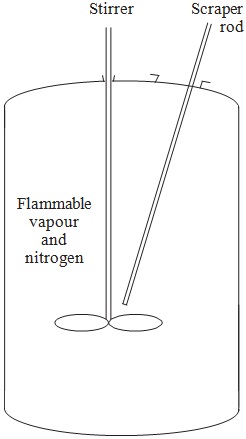
Solid residues had formed on the stirrer shaft and required removal. The vessel was pumped out and charged with nitrogen to minimise the risk of air entering to form a flammable atmosphere of hazardous vapour and air.
The manhole cover was then removed and the residues began to be cleaned off with a scraper rod. The operator, however, went for his lunch before completing the job but left the manhole cover off. Upon his return, a flash fire was caused when he generated a spark by striking the stirrer shaft with the rod.
Write a short report suggesting reasons why this accident occurred.
ASSIGNMENT 2
1. Answer EITHER part (a) OR part (b).
(a) A gas scrubber on an oilrig discharged gas periodically such that an accumulation of hydrocarbon gas nearby had occurred. A contractor welder was dispatched to a job immediately adjacent to the area and it being a shift change and personnel unavailable temporarily, the welder decided to commence welding. As a consequence, an incident occurred.
Describe briefly:
(i) what you imagine was the incident including any hazards existing prior to or during the incident
(ii) the consequences of the incident on personnel, equipment or process
(iii) emergency procedures put into practice during and immediately after the incident
(iv) indications of possible cause(s) of the incident (include any breaches of safety procedures (permits to work, etc.) statutory systems, codes of practice and company safety rules that led to the incident and any other causes or contributing circumstances
(v) recommendations/suggestions that would reduce the possibility of a repetition of the incident.
(This is based on a real incident.)
(b) Describe briefly (as in (i) to (v) of part (a)) a hazardous incident with which you are familiar.
2. (a) Distinguish between a Hazard and Operability Study (HAZOP) and Hazard Analysis (HAZAN).
(b) Explain briefly the quantities shown in the equations used for hazard analysis H = D . fdt = D x 1/2F . T (if F . T << 1).
(c) State the units of H and D and hence determine the units of fdt if any.
(d) FIGURE 1 shows an external intermediate vessel which receives a continuous mixture of hydrocarbon liquid and small variable amounts of water. The water must be separated by settlement into the sump to prevent contamination of a later hydrocarbon processing stage. The sump should be drained every 4 hours by an operator. The operation is facilitated by a sight glass and high level alarm. Under normal conditions the sump would fill in approximately 10 hours.
Carry out a hazard and operability study (HAZOP) on the sump and drain line for deviation of 'No Flow' and 'More Flow' of water, listing possible causes, consequences and recommendations to avoid future deviations.
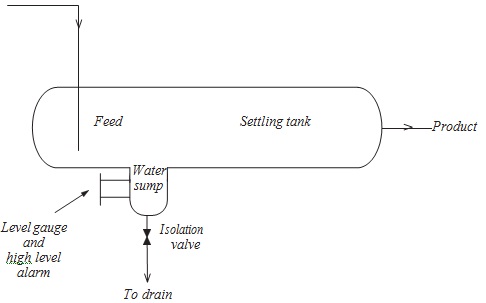
FIG. 1
3. FIGURE 2 shows an improved arrangement for separating water from the hydrocarbon liquid for the process in question 2. Two simple level control loops, LC, have been added to regulate flow control valves on a pumped system. Extra protection is also provided in the form of high level alarms, LA, one to each side of a baffle plate fitted in the tank.
It has been determined that estimating the probable frequency of hydrocarbon passing to the water drain will permit judgement as to whether this would be an acceptable risk.
FIGURE 3 is the cause tree for this TOP event, showing the conventional 'AND' and 'OR' gates together with typical fail-to-danger fault frequencies for the control and alarm equipment, including estimates for electricity and instrument air failure. Also shown are probabilities (3%) for operator failure to respond to the alarm system which is rated at 97% reliable.
(a) Complete the conversion of this cause tree into a FAULT tree, allowing for testing the alarm system once per week. (Use the simple fractional dead time formula.)
(b) State which pieces of equipment have the greatest effect on the top event frequency.
(c) If the reliability of the level detector and controller can be improved from a fault frequency of 2.36 and 1.64 respectively to 0.5 per year, determine the new top event frequency.
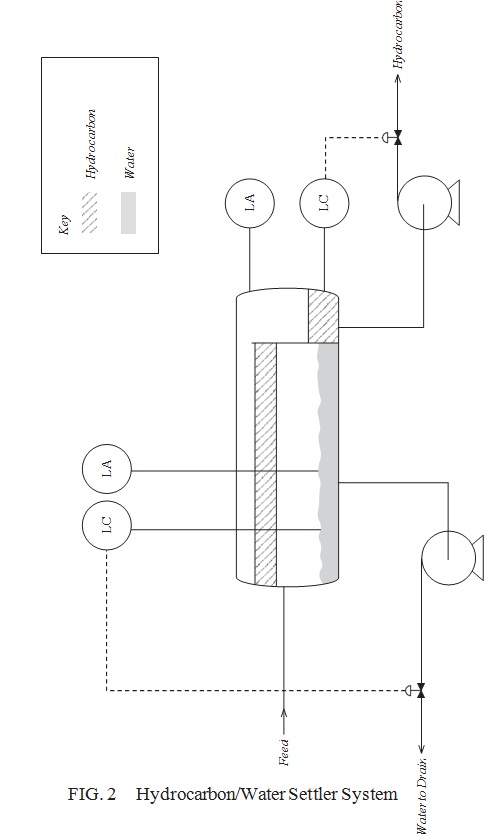
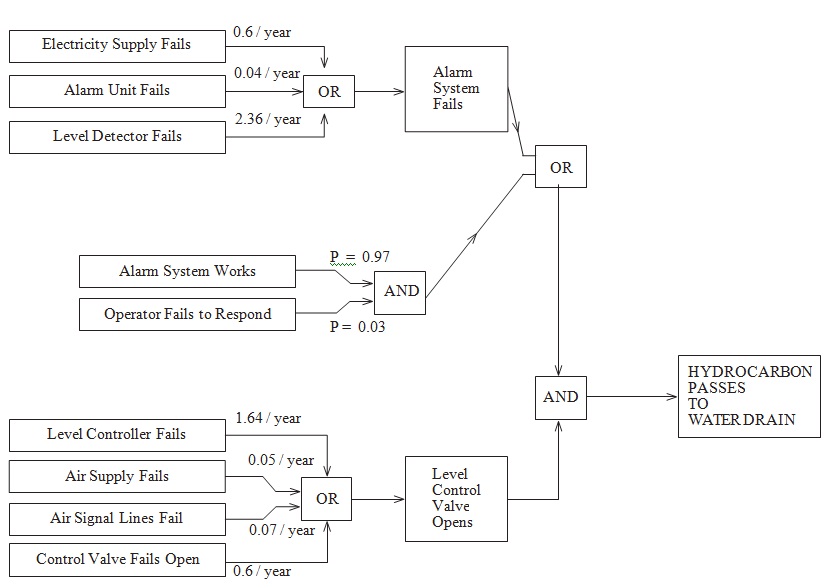
4. A fire water system on an oil rig is supplied by an electric motor driving a mechanical pump. A fire detection system is installed that normally starts the motor automatically but which can be set to manual override. The electric motor is normally supplied by the mains power source but it does have a standby generator for emergencies.
(a) State as a consequence of failure of the pump or motor or detection system, the top event. (It may assist you by referring to FIGURE 4.)
(b) Complete the table for the cases of deviation/failure shown, that is:
(i) pump failure
(ii) motor failure to start
(iii) fire detection system failure
(iv) motor power supply failure
arising from any associated equipment failures or events that would cause the failures from the data given. Indicate whether the associated events are linked by OR or AND operators.
|
Failure
|
Associated equipment or service
|
Linking operator AND/OR
|
Comments
|
|
Pump failure
|
Pump fault
|
None
|
Pump failure = pump fault
|
|
Motor failure to start
|
Motor fault
|
OR
|
|
|
Fire detection system failure
|
|
|
|
|
Motor power supply failure
|
|
AND
|
|
(c) Using the data from TABLE 1 complete the cause tree shown in FIGURE 4.
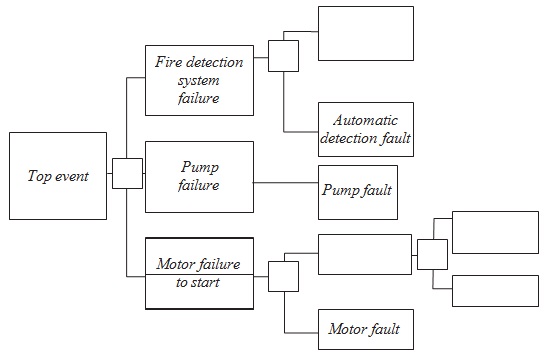
Fig 4
(d) The fault frequencies per year for the following are:
pump = 0.1
motor = 0.05
mains power = 0.5
fire auto detection unit = 0.2
fire detection manual override unit = 0.05
standby generator = 0.25
Assuming the fire detection system can be regarded as a trip system tested every week, calculate the fractional dead time (fdt) for the fire detection system unit and convert the cause tree into a fault tree to determine the frequency of the top event.
5. A housing estate of 250 people is considered to be at risk from a nearby factory on the basis of a hazard analysis which yielded the following data:
(i) The 20% probability of fatalities due to the blast effects of an explosion.
(ii) The 10% probability of additional fatalities due to the release of toxic gas following the explosion.
(iii) The probable frequency of an explosion occurring is once in ten thousand years, i.e. 0.0001 yr-1.
(a) Find the societal and respective average individual risks for these events.
(b) Explain why such data may be misleading if the number of people exposed to the risks is increased by, for example, the expansion of the housing estate.
ASSIGNMENT 3
1. Study the Safety Audit Report (Appendix 1, Lesson 3-1) and the Safety Assessment Questionnaire (Appendix 2, Lesson 3-1) and complete the following:
(i) Compare the following common areas data being sought by a Safety Audit and Safety Assessment Questionnaire by completing TABLE 1 (opposite) and comment on any differences of requirements and coverage.
(ii) As a general comment state any shortcomings you feel may be present in either type of document and any suggestions for improving the report.
(iii) Answer EITHER (a) OR (b)
(a) Complete a concise Safety Audit Report on your place of work or part of it using the Safety Audit Report attached (pages 4 - 7) or one of your own design. Assessment can be by awarding marks or other satisfactory means of assessment.
Explain any means of assessment used or scale of marking.
Clearly indicate where appropriate in the comments column whether the areas covered are satisfactory and also state briefly the reasons why you feel the overall result of the audit is satisfactory or not.
OR
(b) Complete the Safety Assessment Questionnaire attached (pages 8 - 14), which can be for a real or imaginary situation or location. Questions may be added or omitted/struck out if not applicable. Avoid the use of actual names and instead use job titles (e.g. Safety Advisor - Safety Manager or Safety Consultant). Answers should be brief (where appropriate yes/no, for example). Comments should be added where appropriate and a general comment should be made as to whether the safety aspect or situation is satisfactory or not.
2. (a) Invent or select an area of a workplace with which you are familiar and draw a plan upon which is marked the positions of all safety and emergency equipment. Include in the plan any fire hoses, break glasses, fire extinguishers, eye wash bottles, sirens, safe areas, warning notices, escape routes, mustering points, etc. Provide a legend for any symbols used.
(b) Describe an emergency plan with which you are familiar or formulate an imaginary emergency plan incorporating the roles and responsibilities of the control and rescue personnel. Indicate the lines of communication and the situation of any central control station.
(c) FIGURE 1 shows a building with safety equipment installed. The old car park that was the designated muster point in an emergency is to be moved to the position shown for the new car park. The DCS, Switch and Emergency Supply rooms are to be extended to accommodate extra equipment for a process plant extension. The safety equipment and signs for these rooms are shown in their pre- extension positions. Relocate the safety equipment in the extended rooms by modification of FIGURE 1 to indicate new escape routes and a new muster point. State briefly the reasons for your selections.
3. Answer EITHER (a) OR (b)
(a) If you were a Plant Superintendent responsible for, among other things, the plant safety, devise a safety strategy that:
(i) describes briefly the safety procedure that should be implemented prior to entering a vessel
(ii) states the titles and briefly describes the main requirments of any documentation that could accompany vessel entry particularly with reference to certificates or permits
(iii) identifies and describes any:
• personal protection
• environmental/working requirements that may be associated with the vessel isolation and entry procedure.
OR
(b) Describe briefly the vessel entry procedures, documentation, personnel and environmental precautions and any other relevant procedures which have been instituted at your place of work, adding any suggestions you may consider suitable for increased safety.
Attachment:- ASSIGNMENT.rar